拉格海氏四角藻:耐污染水产养殖尾水管理和代谢组学见解的藻类解决方案
IF 4.5
2区 生物学
Q1 BIOTECHNOLOGY & APPLIED MICROBIOLOGY
Algal Research-Biomass Biofuels and Bioproducts
Pub Date : 2025-09-13
DOI:10.1016/j.algal.2025.104303
引用次数: 0
摘要
废水管理提出了一个重大的环境挑战,需要将其重新用于高价值产品,以提高经济可行性和可持续性。本研究探讨了一种耐污染藻类菌株Tetradesmus lagerheimii在处理水产养殖尾水中的潜力,同时探讨了其代谢组学机制。与普通小球藻(Chlorella vulgaris)相比,与本地细菌(IB)共培养时,lagerheimii表现出更强的适应性,生物量增长率高出109.4%。结果表明,藻-菌复合系统具有较高的去除率,可去除91.2%的溶解无机氮(DIN),比单一培养的藻高48.4%,并几乎完全去除溶解有机碳(DOC)和可溶性活性磷(SRP)。代谢组学分析显示,17种细菌衍生代谢物显著上调,包括2-酮丁酸和甘油三酯,它们与藻类生长呈正相关。外源添加这些化合物可使藻类生物量提高1.3倍。此外,特定的细菌属(Blastomonas, Porphyrobacter)在藻球中选择性富集,表明有益的关联。本研究证明了拉格黑氏夜蛾在水产养殖尾水可持续管理中的潜力。本文章由计算机程序翻译,如有差异,请以英文原文为准。

Tetradesmus lagerheimii: an algal solution for pollutant-tolerant aquaculture tailwater management and metabolomic insights
Wastewater management presents a significant environmental challenge, necessitating its repurposing for high-value products to enhance economic viability and sustainability. This investigation examines the potential of a pollutant-tolerant algal strain Tetradesmus lagerheimii in treating aquaculture tailwater, while exploring its metabolomic mechanisms. Compared to Chlorella vulgaris, T. lagerheimii exhibited superior adaptability under co-cultivation with indigenous bacteria (IB), achieving a higher Biomass Growth Rate by 109.4 %. The algal-bacterial system proved highly effective, removing 91.2 % of dissolved inorganic nitrogen (DIN), 48.4 % more than the algal monoculture, and achieving near-complete removal of dissolved organic carbon (DOC) and soluble reactive phosphorus (SRP). Metabolomic profiling revealed 17 significantly upregulated bacterial-derived metabolites, including 2-ketobutyric acid and vanylglycol, which positively correlated with algal growth. Exogenous addition of these compounds enhanced algal biomass by up to 1.3-fold. Furthermore, specific bacterial genera (Blastomonas, Porphyrobacter) were selectively enriched in the phycosphere, suggesting a beneficial association. This research demonstrates the potential of T. lagerheimii for sustainable aquaculture tailwater management.
求助全文
通过发布文献求助,成功后即可免费获取论文全文。
去求助
来源期刊

Algal Research-Biomass Biofuels and Bioproducts
BIOTECHNOLOGY & APPLIED MICROBIOLOGY-
CiteScore
9.40
自引率
7.80%
发文量
332
期刊介绍:
Algal Research is an international phycology journal covering all areas of emerging technologies in algae biology, biomass production, cultivation, harvesting, extraction, bioproducts, biorefinery, engineering, and econometrics. Algae is defined to include cyanobacteria, microalgae, and protists and symbionts of interest in biotechnology. The journal publishes original research and reviews for the following scope: algal biology, including but not exclusive to: phylogeny, biodiversity, molecular traits, metabolic regulation, and genetic engineering, algal cultivation, e.g. phototrophic systems, heterotrophic systems, and mixotrophic systems, algal harvesting and extraction systems, biotechnology to convert algal biomass and components into biofuels and bioproducts, e.g., nutraceuticals, pharmaceuticals, animal feed, plastics, etc. algal products and their economic assessment
 求助内容:
求助内容: 应助结果提醒方式:
应助结果提醒方式:


